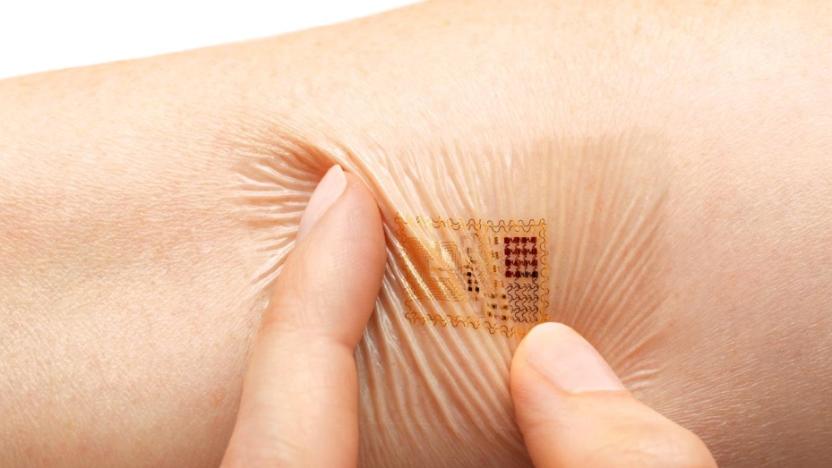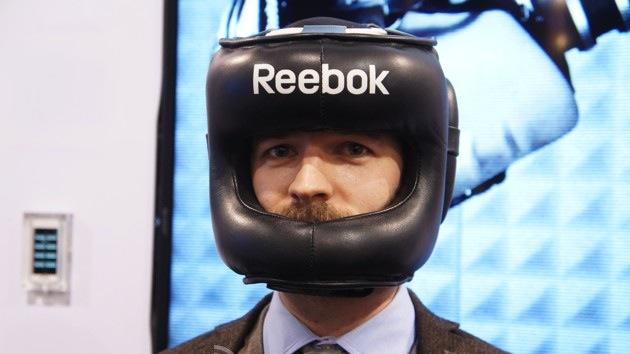MC10
Latest

L’Oreal and John Rogers built a thumbnail-sized UV sensor
L'Oreal is not a name that you'd normally associate with CES, but the cosmetics giant is now a regular exhibitor at the show. This year, the company is demonstrating a thumbnail-worn smart device that's less than two millimeters thick. UV Sense is a battery-free electronic sensor that's designed to monitor your sun exposure and, when coupled with an NFC-enabled smartphone, help limit your skin cancer risk.

The first generation of real wearable tattoos are here
Whenever people talk about the technology of the future, someone will always bring up "tattoo-style" diagnostic technology. MC10, a firm that's emerged out of research by medical wearables pioneer John Rogers, has now been able to make devices like that a reality. The firm is announcing two new products here at CES, one designed for use in research environments as well as a consumer-facing version for the mass market. The first is the BioStamp Research Connect, a flexible wearable sensor that'll adhere to your skin and keep an eye on your vitals.

MC10 takes the guesswork out of fitness with wearable sensors
There's no denying that the wearable craze is upon us, whether we like it or not. MC10 is quite familiar with employing sensors to deliver info on training and athlete performance, and it's looking to do even more. If you'll recall, the outfit was behind the Checklight -- developed alongside Reebok -- for monitoring blows to the head and the potential for concussions. Now the company is working on a sticker that collects data, and more importantly, isn't confined to a specific location -- like your wrist. So, just what's the advantage to compiling the loads of info that your body generates? Well, there are quite a few really.

Five questions for the athletes making wearables you won't take off
MC10's most notable projects -- the Checklight head-impact tracker that protects athletes from the effects of dangerous collisions and a Biostamp "seamless sensing sticker" -- are already at the forefront of sports and medicine technology. Isaiah Kacyvenski and Angela Ruggiero are experienced athletes on the company's sports advisory board, tasked with figuring out ways to use technology to optimize athletic performance. That's certainly great news if you're an athlete in an impact sport trying to avoid the after effects of concussions, or a blogger getting punched in the face by your coworkers. But what about everyone else? Kacyvenski and Ruggiero will join me at Engadget Expand on November 8th for a discussion on how the new technology can help us stay healthy, and ensure that our workouts are refined to get the most impact. You can tune in or attend the event for free, but check after the break for a quick preview, and let us know if you have any questions that need answering.

Testing Reebok's Checklight head impact monitor with a human punching bag
Last year Reebok showed up to CES with the Checklight, a head-impact sensor developed in collaboration with mc10. Problem was, the company didn't really have a way to demo the preproduction version of its G-force sensor. They simply slipped it into a black skullcap and let the press take photos. But, in the interim, it's come to market, offering protection to athletes young and old, for a reasonably affordable $149. This year, the companies came fully prepared with a pair of boxing gloves and some headgear. Naturally, being the masochist I am, I invited anyone who was interested to join me at the Reebok booth on the show floor where they would get to punch me in the face. The response was alarmingly enthusiastic.Not wanting to disappoint, I dutifully donned the black skullcap, with the sensor's blinking display hanging behind my head. Then it was just a matter of removing the glasses, putting on the foam headgear and accepting that I'd brought this on myself. To the Checklight's testament, it appears to work quite well. After taking a surprisingly strong blow from one of the many editors lined up to take a swing, the rotational and directional sensors inside triggered an alert that perhaps my coworker had gotten a little too enthusiastic. The light at the back flashed yellow to indicate that I absorbed a moderate impact. After assuring everyone that I was ok, we continued with the demonstration. But, had the light flashed red, the hands-on (fists-on?) would have been quickly called to a close. While red doesn't mean you have a concussion, it does indicate that you've taken a particularly hard hit and should get checked out. For more of this Engadget editor getting punched in the head, check out the video after the break.

Checklight, the head impact indicator from Reebok and mc10 is now on sale for $149.99
At CES 2013, mc10 and Reebok revealed the Checklight, a product built to help protect athletes who play football, hockey and other impact sports. Today, you can purchase one of your very own in men's, women's or children's sizes for $149.99 from Reebok's website. For your money, you get the sensor strip, a skull cap to keep it snug on your noggin and a micro-USB charger to keep it powered up. For those who've forgotten, the Checklight's a head impact indicator powered by mc10's flexible electronics technology that gives athletes and medical personnel simple, actionable information about impacts to the wearer's head. It's not a concussion detector, per se, but it does provide information about the location, number and intensity of impacts to your dome -- so it's a valuable tool that can help identify those in danger and keep them out of harm's way. Well worth $150, we'd say.

Researchers print biometric sensors directly on skin, make wearable health monitors more durable
MC10 might be best known for its wearable electronics aimed at athletes, but the company also makes a medical diagnostic sticker called a biostamp. Its creator (and MC10 co-founder), John Rogers has refined that design so that it's no longer an elastomer sticker -- now he can apply the biostamp's thin, stretchy electronics directly on human skin, and bond it with commercially available spray-on bandage material. By losing the elastomer backing of the original biostamp and applying the circuits directly to the skin, Rogers and his team at the University of Illinois were able to shave the device's thickness to 1/30th of the (already quite thin) biostamp. That super thin profile means it conforms even better to the contours of human hide and makes it shower- and swim-proof during the two weeks it lasts before being naturally exfoliated with your skin. For those unfamiliar with what the biostamp does, it's a mesh of circuits and sensors that can record electrophysiological data like skin temperature and hydration state of the wearer. The new biostamp won't be in your doctor's tool box any time soon, however, as Rogers and his team are still refining the wireless power and communication technologies it leverages. Of course, once those problems are solved, there's a good chance we'll see MC10 turning it into a commercial product.

Engadget Expand speakers, Round Six: Nest, Sprint, MC10 and sci-fi up in lights
We've already got quite a lineup unveiled so far, but the fun doesn't stop now, my friends -- if anything, we'll be ratcheting up the excitement as we get closer and closer to Expand in San Francisco this March 16 and 17th. We'll have full profiles of all 10 of our Insert Coin Semi-Finalists rolling over the next few days, and your audience vote will determine which top five will also get to demo on our stage -- and voting will kick off today at 12:30pm PST / 3:30pm EST! Stay tuned! But if you still need more reasons to attend Expand, how about 10 of 'em? Followed by four more inspiring speakers you'll get to see -- all for the low, low price of 50 bucks: Matt Rogers: Founder & VP of Engineering, Nest Dave Icke: CEO, MC10 Ryan Sullivan: Director of Product Delivery, Sprint John Scalzi: President, Science Fiction and Fantasy Writers of America Read on for the Engadget editors you most want to meet...

Reebok and mc10 team up to build CheckLight, a head impact indicator (hands-on)
Concussions have always been a concern for those who play contact sports. However, there's been a renewed focus in recent years by the sports community -- the NFL in particular -- to learn more about concussions in the interests of promoting player safety. Pro leagues aren't the only folks tackling the problem, though. Verizon, Intel and Ridell are all building systems to help identify concussed players. Reebok and mc10 have collaborated to create CheckLight, a head impact indicator meant to make it easy to see when an athlete has taken a dangerous blow to the head. The CheckLight is composed of two parts: a sensor device built by mc10 and skull-cap made by Reebok. The sensor itself is a strip of plastic filled with flexible sensors connected to a small microcontroller module with three indicator LEDs and a micro-USB port. One LED serves as a battery level indicator, one flashes yellow after moderate impacts and a third flashes red for severe blows. mc10 wasn't willing to share the exact hardware inside, but we know that it's got a rechargeable battery and has rotational acceleration, multi-directional acceleration, impact location and impact duration sensors. Data from those sensors is then run through the company's proprietary algorithm to determine when to fire the LEDs. We got to chat with Isaiah Kacyvenski -- mc10's Director of Licensing and Business development and ex-NFL player -- about the CheckLight and the role it has to play in keeping athletes safe, so join us after the break for more.

Reebok-CCM partnering on impact-sensing flexible sports cap, hopes to improve real-time injury analysis
While the whack of two helmets might be an unavoidable part of some high intensity sports, knowing a little more about what's going on during those impacts can mean the difference between a time out, and time in hospital. Reebok-CCM Hockey and electronics firm MC10 have just announced that they are developing a wearable cap that will register the strength and severity of head impacts during games. The project is actually aimed at all sports and age-groups, and uses high-performance electronics reshaped into an ultra-thin, breathable, flexible system that technology partner, MC10, expects to also be much more affordable. The cap will allow quick analysis through the use of different colored readouts, illustrating the strength of impact. The product won't be commercially available until next year however, but we're already thinking of potential worthy collaborations.

EES packs circuits into temporary tattoos, makes medical diagnostics fashionable
Flexible circuit pioneer John Rogers and his team are at it again. This time he's developing a wearable, ultra-thin circuit that attaches to your skin just like a temporary tattoo. The Epidermal Electronic System (EES) consists of circuits which could contain electrodes capable of measuring brain, heart and muscle activity in the same way an EEG does now, transmitting this data wirelessly to your doctor. Because it's flexible and bonds to the skin, it can be worn for extended periods, unlike traditional diagnostic pads used in hospitals today. In the lab, the devices were solar-powered with embedded photovoltaic cells -- heavier duty circuits would require inductive charging to be practical. Rogers' team also looked into the tech acting as a game controller (they wired it up to someone's throat and played Sokoban with voice commands, still managing to yield a 90 percent accuracy rate), but it's some way off from replacing your SIXAXIS. One of the problems encountered concerned RF communication -- perhaps they should get on the horn to their friends in Oregon and build those fashionable diagnostic pants we're eagerly waiting for.

Reebok sets sights on flexible computing sportswear, partners with startup team
Science has prototyped flexible versions of just about everything a ever-loving geek needs: displays, memory, batteries, LEDs, speakers and an input device or three. Now, Reebok's looking to put some of that computing power up our sleeves. The apparel manufacturer's teamed up with MC10 -- a startup founded by our old friend John Rogers, who helped pioneer the field -- with the intent to build "conformable electronics" into high-performance clothing for athletes over the next couple of years. Though the company told MIT Technology Review the devices typically consist of thin silicon strips printed onto flexible materials, and that they might they might measure metabolism and performance using embedded sensors, hard details are few -- the only thing we know for sure is that a flexible tech scientist just scored a partnership with a major company, and we're hopeful they'll make something neat. PR after the break.

Workhorse Certeza MC10 brings WWAN and ExpressCard to netbook scene
Yeah, we've seen netbooks with integrated WWAN / WiMAX before, but it's still pretty far left on the "uncommon" scale. Workhorse PC, a little known company that generally sticks to making products for governments and educational institutions, is apparently looking to vie for its piece of the netbook pie with the Certeza MC10. Overall, the 10.1-incher is pretty average, sporting an Atom N270 CPU, 1,024 x 600 resolution panel, up to 2GB of RAM, a 4-in-1 card reader, a 1.3 megapixel webcam, WiFi, Bluetooth and a 4- or 6-cell battery. Keeping it differentiated is the inbuilt WiMAX and WWAN options, not to mention the trio of OS choices (Ubuntu Linux, Windows XP or Windows Vista). The machine will be available starting at $399 (for the Linux model) and will go to around $549 (for the Vista model); regrettably, there aren't any actual launch dates to speak of.[Via Laptop Mag]






